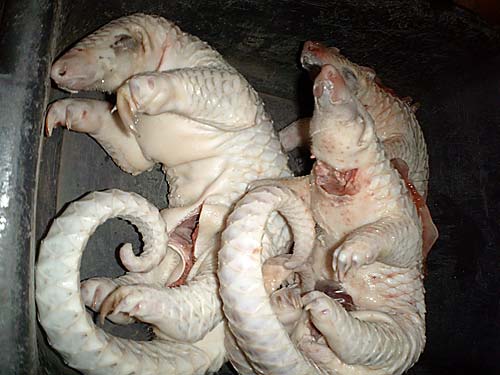Boarding a suspect fishing vessel in the early morning of June 6th, Chinese customs officials discovered 2,090 frozen pangolins and 92 cases of pangolin scales, weighing an astounding 3,960 pounds. Manned by five Chinese and one Malaysian national, the boat was awaiting instructions via satellite phone as to where to meet another ship to transfer the illegal cargo while still at sea.
“The use of satellite phones and trans-shipment of cargo at sea are indicative of the increasingly sophisticated methods being used by the organized criminal gangs involved in wildlife crime,” said James Compton, TRAFFIC’s Asia Pacific coordinator, in a press release.
All four species of Asian pangolin are banned under the Convention on International Trade in Endangered Species (CITES). Despite the ban, pangolins remain one of the most heavily trafficked species in Asia. Illegal pangolin meat is considered a delicacy in Southeast Asia and its scales are used in traditional medicine. Some pangolins are even stuffed and displayed. The trade has pushed two species, the Chinese and Malayan or Sunda pangolin, to be evaluated as Endangered by the IUCN Red List. Despite a lack of data—given the mammals’ nocturnal and shy habits—researchers believe that both of these species’ populations have dropped by 50 percent in just 15 years.
The other two species, the Philippine and the thick-tailed pangolin, are classified as Near Threatened. The ecological role of pangolins in Asia has not been well-established, but since they feed on ants and termites they likely help control these populations.
The seizure is also important as it was made by Chinese officials, who have at times turned a blind eye to illegal wildlife trafficking.
From pangolins to tigers, rhinoceroses to elephants, and turtles to rodents, a wide-variety of species are threatened by the global illegal wildlife trade. East Asia, where a number of species are consumed in traditional medicines or as food, isn’t the only destination: a recent report found that 270 tons of illegal bushmeat from Africa moves through one European airport (Charles de Gaulle in Paris) every year.

Poached pangolins descaled. The meat will be sold for food, while the scales are sold as traditional remedies. Photo courtesy of: TRAFFIC.
Related articles
Pangolins threatened by illegal trade for traditional Chinese medicine
(07/14/2009) While their trade has been prohibited under the Convention on International Trade in Endangered Species of Wild Fauna and Flora (CITES) since 2002, Asian pangolin populations are rapidly declining due to poaching for use in traditional Chinese medicine, report conservationists. Trade has nearly wiped out the species in Cambodia, Viet Nam and Laos, once strongholds for the scaly, toothless anteater.
Malaysia introducing tough new wildlife laws
(05/20/2010) By the end of the year, Malaysia will begin enforcing its new Wildlife Conservation Act 2010 including stiffer penalties for poaching and other wildlife-related crimes, such as first time punishments for wildlife cruelty and zoos that operate without license.
(03/18/2010) The United Nation declared 2010 as the International Year of Biodiversity (IYB). One of the goals of the IYB is to celebrate the achievements of the Convention of Biological Diversity signed by 192 countries since 1992. But what have we accomplished since 1992? Did we put an end to biodiversity loss? The truth is that there is not much to celebrate at all. Asia is a perfect example where the animal crisis and the loss of biodiversity have worsened over decades. The first question that should come to mind is: how many species have vanished in Asia because of human activities? Records of recently extinct species in Asia show 71 species that have disappeared in the wild. Examples include the Yunnan lake newt (Cynops wolterstorffi) from China, the Bonin thrush (Zoothera terrestris) from Japan, or the redtailed black shark (Epalzeorhynchos bicolor) from Thailand.
